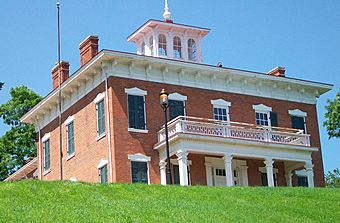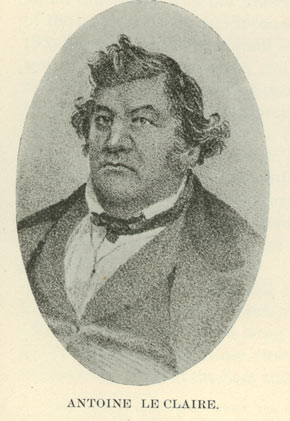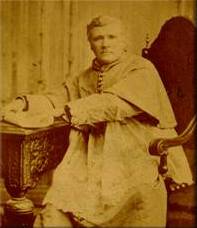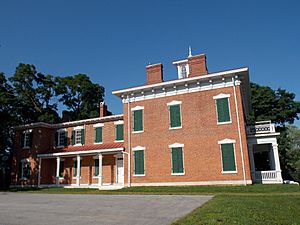Antoine LeClaire House facts for kids
|
Antoine LeClaire House
|
|
 |
|
| Location | 630 E. 7th St. Davenport, Iowa |
|---|---|
| Area | 1 acre (0.40 ha) |
| Built | 1855 |
| Architectural style | Italianate |
| NRHP reference No. | 74000809 |
Quick facts for kids Significant dates |
|
| Added to NRHP | March 22, 1974 |
The Antoine LeClaire House is a special old building in Davenport, Iowa. It was once the home of Antoine Le Claire, who helped start the city of Davenport. This house also served as a home for two Catholic bishops. Built in 1855, it's now a community center. It was added to the National Register of Historic Places in 1974 and the Davenport Register of Historic Properties in 1992.
Contents
History of the House
The Antoine LeClaire House has a rich history. It tells the story of one of Davenport's most important founders. It also shows how the city grew and changed over time.
Antoine Le Claire, City Founder
Antoine Le Claire was a very important person in early Davenport. He worked as an interpreter for the U.S. Government. He was stationed at Fort Armstrong on Rock Island.
In 1832, he helped sign a peace treaty. This treaty was between the Sac and Meskwaki tribes and the United States. It happened after the Black Hawk War. The tribes gave Le Claire two pieces of land in Iowa. One of these pieces became part of the city of Davenport. Le Claire helped create Davenport in 1836.
Le Claire became Davenport's first important citizen. He started the first church, St. Anthony's. He also set up the first ferry service, a steam mill, a store, a hotel, and a foundry. He was very generous. He helped start two other churches. He also gave land for the Scott County Courthouse. He even gave land for Iowa College, which is now Grinnell College. Some people believe Le Claire also helped people escape slavery through the Underground Railroad.
Le Claire's Homes
Antoine Le Claire built his first house in 1833. It was on the spot where the Black Hawk Treaty was signed. This first house was a small log cabin. Later, it was replaced by a small white house. This house became known as the Treaty House.
Le Claire and his wife, Marguerite, lived in this simple house until 1855. Then, they built a grand Italianate mansion. This new house was in the middle of the Le Claire Reserve. This Reserve was part of the land given to him by the tribes. It covers much of the east side of Davenport. The new mansion showed how much the city had grown in just 20 years.
Le Claire later gave the Treaty House to the Mississippi and Missouri Railroad. It became Davenport's first train station. It was also the first train station west of the Mississippi River. The house had to be moved from its original spot.
With Le Claire's help, the first railroad bridge was built across the Mississippi River. It was located just below his new mansion. The bridge was finished a year after the house. The first train to cross the river was even named the Antoine LeClaire. A steamboat hit the bridge, and the lawsuit that followed became one of Abraham Lincoln's most famous cases.
Antoine and Marguerite Le Claire lived in the mansion until they passed away. Antoine died in 1861, and Marguerite in 1876. They did not have children of their own. However, they informally adopted his nephew, Louis Antoine Le Claire. Louis inherited their property after they died.
Home for Bishops
Antoine Le Claire gave the land for St. Anthony's church to the Catholic Church in 1839. This land helped support the church in Davenport. Money from businesses on this land helped Davenport become a city with its own bishop in 1881.
John McMullen from Chicago became the first bishop of the Diocese of Davenport. The church leaders bought the LeClaire House for him to live in. Sadly, Bishop McMullen died in the house less than two years later.
His successor, Henry Cosgrove, moved into the house in 1884. When Bishop Cosgrove died in 1906, the next bishop, James Davis, chose not to live there. The house needed many repairs and updates. The diocese then sold the LeClaire House in 1908. They bought the F.H. Miller House as the new home for the bishop.
Later Years and Renovation
After the Catholic diocese sold the house, it was turned into apartments. Over time, the original porches were removed. The brick was painted white. By the time World War I started, the neighborhood began to decline. The LeClaire House also started to fall into disrepair.
In 1976, the city of Davenport bought the house. This was part of their Bicentennial projects. Since then, a big renovation project has been happening. A lot of work has been done to both the outside and inside of the house. All the old systems, like plumbing and heating, have been replaced.
Architecture of the House
The LeClaire House is a two-story mansion. It is made of brick and has 14 rooms. It is built in the Tuscan Italianate style. The house sits on top of a bluff, about 125 feet (38 m) above the Mississippi River.
The rooms are divided evenly on both floors. The front part of the house has four rooms on each floor. There are three more rooms in a back wing. A long hallway runs from the front to the back of the house on both floors.
The outside of the house has a low, sloped roof. It has wide eaves (the parts of the roof that hang over the walls) with decorative brackets. There is also a small tower, called a belvedere, on top of the roof.
Inside, the house has nine fireplaces. The ceilings are very high, about 12 feet (3.7 m) tall. There are fancy plaster designs on the ceilings. A beautiful three-story spiral staircase connects the floors. The house also has some Greek Revival design elements. You can see these in the doorway, which is framed by flat columns called pilasters. The windows have decorative curved tops called scroll pediments.
The property once had a circular driveway. It was lit by gas lamps. The estate also had buildings for carriages, a summer kitchen, and an ice house. There was even a plum grove.
Why the House is Important
The LeClaire House is important for two main reasons. First, its architecture is special. It was one of the first Italianate homes in Davenport. It also influenced how other large homes in the city were designed.
Second, Antoine Le Claire himself was very important. He was a founder of the city. He was also one of its most generous and successful business people in the early years. He played a big part in starting the Catholic Church in Davenport. Even though he died before the diocese was officially created, he gave the land for both St. Anthony's and St. Margaret's churches. He largely helped build St. Margaret's, which became the city's first Catholic Cathedral.






